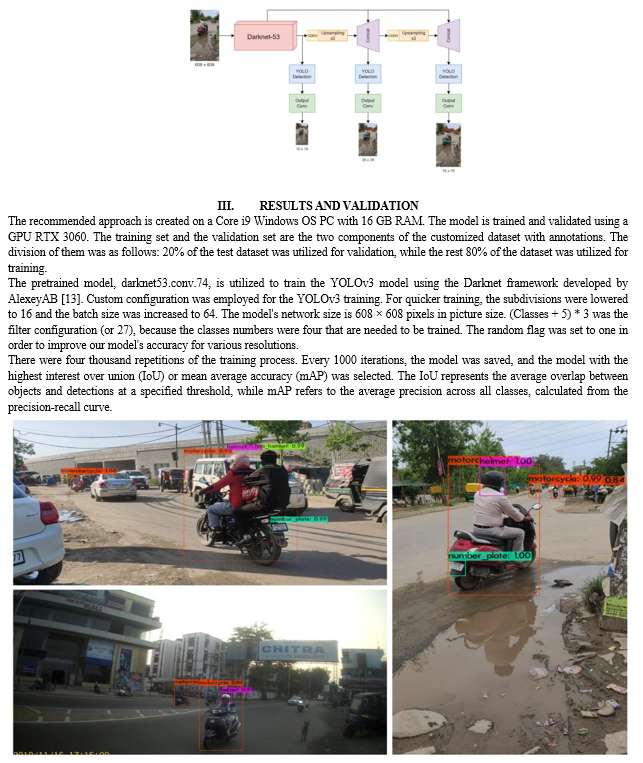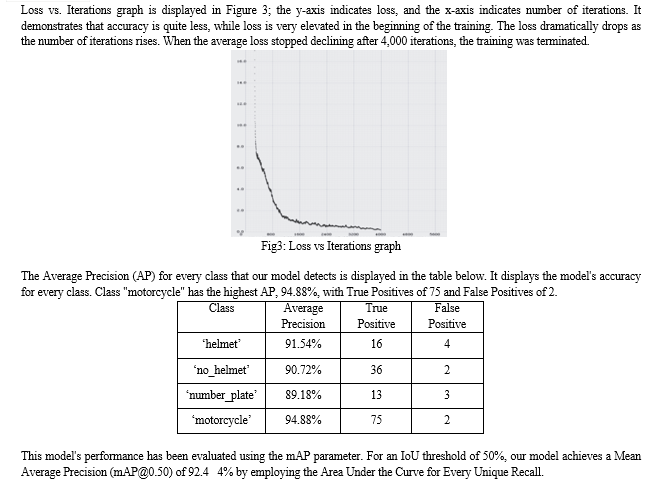Ijraset Journal For Research in Applied Science and Engineering Technology
- Home / Ijraset
- On This Page
- Abstract
- Introduction
- Conclusion
- References
- Copyright
Efficient Helmet and Number Plate Detection using YOLOv3: A Road Safety Perspective
Authors: Kaushik Paul, Kartikey Singh, Shivani Sharma
DOI Link: https://doi.org/10.22214/ijraset.2024.60872
Certificate: View Certificate
Abstract
Object recognition is an important aspect of machine learning and CV tasks, in addition to many real-world uses, including traffic welfare. In this work, we provide a YOLOv3-based trained model for number plate and helmet recognition in photos. Pre-processing the data improved its quality and diversity. We gathered a dataset of annotated photos of helmets and licence plates. We trained our model with a multi-phase program for learning rates using the dataset, then we assessed its efficacy on an independent test collection set. Additionally, we examined its advantages along with disadvantages of the methodology we used also spoken about potential developments that can be done in coming times to raise the model\'s precision and effectiveness. Our study advances the development of realistic, efficient, along systems for detecting objects that increase traffic welfare.
Introduction
I. INTRODUCTION
Computer vision has drawn a lot of attention recently as a topic with enormous potential to revolutionise many areas, including transportation safety. One of the most important tasks in computer vision today is object detection, which makes it possible to recognise and identify things or individuals in footage clips or digital photos. By making feasible the real time instantaneous identification and evaluation of possible risks and infractions on roadways, accurate and efficient object detection systems can considerably improve traffic welfare.
Helmets worn by motorcycle riders and vehicle licence plates are two of the many items of relevance in the context of transportation safety. In the case of an accident, helmets lower the rider's chance of suffering serious head injuries and offer vital protection. Furthermore, accurate number plate identification and recognition support law enforcement initiatives by making it possible to identify traffic infractions and guaranteeing the accountability of car owners.
According to our investigation, a YOLOv3-based paradigm can be used to identify helmets and licence plates in photos taken on Indian highways. A cutting-edge deep learning architecture called “You Only Look Once version 3” (YOLOv3) is renowned due to its exceptional accuracy and quickness in object identification tasks [1]. We hope to create a workable and efficient method to deal with the difficulties presented by the helmet and number plate detection procedure by leveraging YOLOv3's capability.
In order to validate the necessity of this kind of system, we polled 500 riders of two-wheelers in Mohali. According to the poll, only 45% of riders usually wear helmets. Furthermore, 25% of bikers who do wear helmets do so improperly.
We developed an extensive collection of annotated photos that are specifically suited to Indian road conditions in order to aid in the evolution of our model. This gathering of number plates and helmets appears in a range of sizes, shapes, orientations, and lighting conditions. In order to ensure the resilience of our model, we have carefully pre-processed the dataset to improve its quality and diversity.
A. Identification of Problem
India's growing number of road accidents is a serious problem that has to be addressed. 32 pedestrians died in traffic accidents in 2020, compared to 64 pedestrians who died in total in 2019. According to the traffic branch's records, there were 127 reported accidents up until November 2020, with 290 people reported injured. Out of those hurt, 78 people only had minor wounds. On the other hand, the city saw 199 accidents in 2019, which resulted in 206 fatalities and 463 serious injuries. In addition, 163 people had minor injuries during that time. The startling figures highlight the need of finding a solution for this problem.
Motorcycle Helmets reduce the possibility of brain injuries by 70% and the chance of fatal outcomes by 40%, per WHO research. Motorcycle riders' failure to wear helmets, despite their known benefits, is still a serious issue in many nations, especially developing nations. [4].
B. Identification of Task
Several tasks must be completed in order to design a solution that can identify and recognize helmets and number plates on cars. Three major categories can be used to group these duties.
- Finding pertinent datasets: Finding and gathering pertinent datasets of pictures and videos of moving cars is the initial step. Both the model's training and testing will be conducted using these datasets.
- Model construction: Utilizing the YOLOv3 method, the second task entails creating an object detection model. The gathered statistics will be used to train the model, which will enable it to identify helmets and license plates on moving vehicles in real time.
- Model testing: The last step is to put the constructed model to the test using actual traffic camera footage. This will entail assessing the model's precision in identifying and detecting helmets and license plates.
By completing these pieces of work in this way, we may create a thorough structure for determining, creating, and evaluating a YOLOv3 algorithm-based method for recognizing and detecting number plates and helmets.
C. Related Work
Assuring that motorcycle riders wear helmets on a regular basis and reliably identifying infractions of this safety precaution present considerable difficulties when depending exclusively on manual surveillance. With so many motorcycles on the road, human-based monitoring is both impracticable and insufficient. The requirement for human participation in technical procedures persists, despite the aid of surveillance cameras. Researchers have resorted to Intelligent Transportation Systems (ITS) that make use of computer vision techniques-specifically, object recognition and categorization through machine learning algorithms—to overcome these issues.
To create systems for the identification and categorization of motorbikes with and without helmets, numerous studies have been carried out. A method for head region analysis in both still images and single frames extracted from video footage is proposed by Chiverton et al. [5] using Support Vector Machine (SVM) trained on HOG characteristics. The evaluation only included a small number of photos, despite the method's excellent accuracy.
Silva et al. demonstrated a helmet detection system that begins with the segmentation of moving objects using descriptors. Next, it follows the head region-related Region of Interest (ROI) to locate the helmet. Based on this region, the algorithm divides the data into helmet and non-helmet categories. Their method's drawback, though, is the application of the circle Hough transform, which can lead to a mistaken classification between the helmet and the head because of their comparable shapes [6].
In order to recognize motorcycle riders, Dahiya et al. [7] proposed a helmet recognition method that blends object segmentation and background reduction techniques. The suggested solution uses binary classifiers and visual features to determine if the rider has a helmet on. Their approach's immediate immediacy and minimum adjusting required to adapt to new conditions are key advantages. The performance of the three different feature representations for classification is also compared in the research. Based on real-world data, the suggested method exhibits a high accuracy rate of 93.80%. It is noteworthy, therefore, that the processing time needed—11.58 frames per second—was comparatively slow [7]. The two parts of the technique work together to maximize precision and reduce mispredictions. The system first determines whether a motorcyclist is present in the video frame. This first step makes sure that any further analysis is limited to the appropriate regions that have riders. The emphasis switches to identifying the rider's head and if a helmet is worn or not during the second phase. This two-step method reduces incorrect predictions by focusing the study on particular interest zones. Because pre-processing techniques like HOG, SIFT, and SVM are used, this methodology still processes data slowly even though it is less computationally expensive than other methods.
A variation of YOLO (“You Only Look Once”) paradigm that makes use of the network of Darknet-19 backbone is called YOLOv2 [8]. Inspired on the VGG16 [9] model, this backbone network design uses 2x2 maximum pooling layers and 3x3 convolutions. These layers are typically used by the network architecture to down sample the feature map. The feature map's width and height are half, but the number of channels is doubled. YOLOv2 is able to hold onto its speed advantage because of this down sampling process.
Nevertheless, YOLOv2's backbone network might not have the depth required to detect more complex semantic features in photos, despite its speed. The capacity of the model to comprehend intricate perceptible elements and connections among the data could be impacted by this constraint. Furthermore, because of its limited bounding box predictions from each grid cell, YOLOv2 could not be as effective at accurately identifying targets with large-scale changes. YOLOv2 may face difficulties in making predictions about targets that significantly deviate from the training set in size or experience considerable modifications.
A study by Sridhar et al. [10] focused on employing YOLOv2 to detect helmet wearing. Their main goal was to use deep convolutional neural networks (CNNs) to detect whether or not people were wearing helmets. The suggested approach was identifying motorbikes first, then categorizing them according to whether they had helmets on. Compared to conventional algorithms, they produced better experimental results thanks to their architecture.
D. Objectives
Many targets have expressed interest in achieving the objective:
- Developing a stable and strong method for recognizing license plates and helmets.
- Identifying and locating helmets, as well as efficiently and accurately identifying registration plates in a range of situations, such as dimly lit areas and unfavorable weather.
- Thorough validation and testing of system performance in real-world settings to guarantee adherence to industry standards.
- Assess the system's efficacy by contrasting its results with those of other techniques for number plate and helmet identification and detection.
These goals are clear, succinct remarks that outline checkpoints of the project. These can be observed and can be concrete, and they are able to be assessed or verified with the use of particular performance indicators.
II. PROPOSED APPROACH
Several crucial phases are included in our method for YOLOv3-based helmet and license plate recognition on Indian roads in order to accomplish precise and effective object detection. First, we manually gather video frames and compile them into a manual-based database. Multiple frames from different sources are collected to ensure diversity in our dataset.
To enhance the quality of the gathered dataset, redundant images, specifically duplicates are eliminated. Then, we add four labels—"helmet”, “no helmet”, “number plate”, and “motorcycle” to the chosen frames. The "Label Studio" software is used for this annotating process [13].
There are test and training sets within the annotated dataset. We use a pre-trained YOLOv3 model for transfer learning for the training phase [1]. We may modify the pre-trained algorithm to reliably identify helmets and license plates by fine-tuning it with our annotated dataset.
Overall, the pipeline we've suggested—which is depicted in Fig.1—involves manual gathering information, preprocessing, annotating, dividing datasets, and transfer learning. By using the mentioned strategy, we hope to improve transportation safety by creating a workable and efficient way to identify helmets and number plates on Indian roadways.




Conclusion
A. Conclusion To conclude, YOLOv3-based helmet and license plate detection technology has shown to be a viable way to address the need for road safety and law enforcement. In order to help authorities enforce laws and enhance traffic safety measures, the technology achieved great accuracy in real-time detection and recognition of helmets and number plates. Even though there were some variations from the anticipated outcomes, these variations offer important insights for further study and advancements in the gathering of datasets, training models, and enhancement of the system. B. Future Work Maybe in the time ahead, we\'ll strive to gather much more varied and extensive dataset that covers a greater variety of difficult situations. Optimizing the system by algorithmic means can also improve its performance. Additionally, the system\'s processing performance might be increased by utilizing hardware accelerators like GPUs or specialized CPUs for deep learning.
References
[1] Redmon, Joseph & Farhadi, Ali. (2018). YOLOv3: An Incremental Improvement. [2] Nannan, Lu & Liuai, Wu. (2023). Research on Helmet Wearing Detection Based on Improved YOLOv8 Algorithm. 910-917. 10.1109/ITAIC58329.2023.10408800. [3] Huang, Li & Fu, Qiaobo & He, Meiling & Jiang, Du & Hao, Zhiqiang. (2021). Detection algorithm of safety helmet wearing based on deep learning. Concurrency and Computation: Practice and Experience. 33. 10.1002/cpe.6234 [4] Toroyan, T. (2006). New road safety manuals for decision makers and practitioners. Injury Prevention. 12. 10.1136/ip.2006.013490. [5] Chiverton, John. (2012). Helmet presence classification with motorcycle detection and tracking. Intelligent Transport Systems, IET. 6. 259-269. 10.1049/iet-its.2011.0138. [6] Boonsirisumpun, Narong & Puarungroj, Wichai & Wairotchanaphuttha, Phonratichi. (2018). Automatic Detector for Bikers with no Helmet using Deep Learning. 1-4. 10.1109/ICSEC.2018.8712778. [7] Dahiya, Kunal & Singh, Dinesh & Chalavadi, Krishna Mohan. (2016). Automatic Detection of Bike-riders without Helmet using Surveillance Videos in Real-time. 10.1109/IJCNN.2016.7727586. [8] Redmon, Joseph & Farhadi, Ali. (2017). YOLO9000: Better, Faster, Stronger. 6517-6525. 10.1109/CVPR.2017.690. [9] Simonyan, Karen & Zisserman, Andrew. (2014). Very Deep Convolutional Networks for Large-Scale Image Recognition. arXiv 1409.1556. [10] P. Sridhar, M. Jagadeeswari, S. H. Sri, N. Akshaya and J. Haritha, \"Helmet Violation Detection using YOLO v2 Deep Learning Framework,\" 2022 6th International Conference on Trends in Electronics and Informatics (ICOEI), Tirunelveli, India, 2022, pp. 1207-1212, doi: 10.1109/ICOEI53556.2022.9776661. [11] Qian, YueJing & Wang, Bo. (2023). A new method for safety helmet detection based on convolutional neural network. PLOS ONE. 18. e0292970. 10.1371/journal.pone.0292970. [12] Susa, Julie & Maaliw III, Renato & Ceribo, Carla & Macalisang, Jonel & Fabro, Bernard. (2022). An Efficient Safety and Authorized Helmet Detection Using Deep Learning Approach. 1-5. 10.1109/SIST54437.2022.9945729 [13] “heartexlabs/label-studio: Label Studio is a multi-type data labeling and annotation tool with standardized output format.” https://github.com/heartexlabs/label-studio [14] FFmpeg. (n.d.). https://ffmpeg.org
Copyright
Copyright © 2024 Kaushik Paul, Kartikey Singh, Shivani Sharma. This is an open access article distributed under the Creative Commons Attribution License, which permits unrestricted use, distribution, and reproduction in any medium, provided the original work is properly cited.

Download Paper
Paper Id : IJRASET60872
Publish Date : 2024-04-23
ISSN : 2321-9653
Publisher Name : IJRASET
DOI Link : Click Here
 Submit Paper Online
Submit Paper Online

